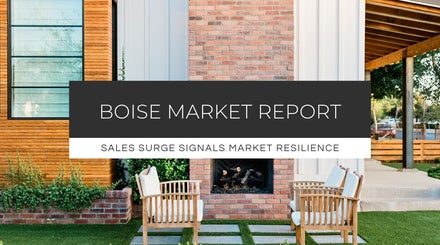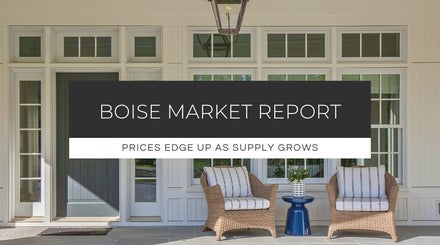
The Treasure Valley’s severely-low housing supply continues to stoke a hyper-competitive real estate market, sprouting new sales prices records across Ada and Canyon County.
February’s frigid market is historically slow to thaw, but the new, widespread peaks—primarily caused by a lack of for-sale signs—point to a scorching Spring Selling Season.
Available home supply remains at a critical level, forcing price jumps as relentless demand continually outstrips resale listings. In new construction, supply bottlenecks, land shortages, material delays, and labor scarcity are combining to extend build timelines, further reducing home inventory.
As the Treasure Valley braces for a fast-approaching Spring, climbing mortgage rates and extraordinarily low supply are adding even more pressure to buyers (and sellers) entering the competitive market.
- Ada County reached a median home price record of $549,900. Just shy of a $4,000 jump from the previous number set in December, that’s a year-over-year increase of $97,150 (21.46% appreciation).
- Canyon County continued its 2022 climb as it marked its second record in as many months. At $434,000, homes have jumped $66,000 (17.93%) since February ‘21.
- Boise’s record sale price of $525,000 is a twelve-month bump of $75,500, or 16.54%.
- Meridian ended at $547,000. Compared to last February, that’s a whopping gain of $107,050 (24.33%).
- Nampa marked its first new record since October ‘21 with $444,990, a yearly increase of $84,080 (23.30%).

Ada County Home Supply Locked into Extreme Seller's Market
Imagine you and 11 other shoppers are standing in a grocery store, waiting for the milk to be restocked. An employee approaches with a single gallon, holds it up for everyone to see, and starts taking bids.
For many Treasure Valley buyers, that’s what last year’s market felt like. This year, available inventory has moved above the once-in-a-generation lows, but shoppers are still competing 5-to-1. The devastated supply is feeding a hyper-competitive market, and as demand continues to drastically outstrip supply, it’s easy to see why home prices keep reaching new records.
As a whole, the Treasure Valley stands at a little over two weeks of homes for sale. If demand kept its pace and listings stopped, Ada County would run out of properties in 15 days. Canyon County would dry out in 17.
While a numbers-to-numbers comparison shows “double the available inventory” from last year, Boise real estate is nowhere near the 4-6 month supply that marks a healthy market, and exceptional demand is keeping things intensely competitive.
Over the last few years, we’ve seen demand surge as historically low mortgage rates, a strong economy, a low unemployment rate, and pandemic-forced changes brought more homebuyers to the Treasure Valley, amplifying pre-existing market trends.
Yet, the low-supply, high-price market isn’t exclusive to Idaho. Nearly every metro area in the county faces the same population and demand growth—Boise just happens to be one of the more extreme examples.
Building a Supply Crisis: 13 Years in the Treasure Valley
The Boise area has been prohibitively underbuilt since the Great Recession. According to our estimates, 13 years of limited construction has compounded, resulting in a lack of 15,000 new homes—and that number is growing.
Leading to the recession, lax lending standards were blowing a bubble, and the builder assembly line was churning out new build after new build, inflating the housing supply past the healthy market threshold. Then the bubble burst and buyers disappeared. Starkly contrasting today’s real estate issues, that more-homes-than-buyers equation swallowed the construction industry, and since the recession ended in mid-2009, new builds have completely fallen off the map.
 The number of new homes built vs. estimated new household formations by year. The cumulative single-family housing deficit has accrued to over 15,000 homes at current home prices.
The number of new homes built vs. estimated new household formations by year. The cumulative single-family housing deficit has accrued to over 15,000 homes at current home prices.
Short supply isn’t just a Treasure Valley issue.
According to the U.S. Census Bureau, the entire country is shy of 5.8 million new homes. At the end of January 2022, the National Association of Realtors showed only 1.6 months of existing home supply for the nation. The lowest level on record since the NAR began tracking supply in 1999.
Boise’s inventory is nearly a fourth of the national average, ending February at 0.43 months of supply.
Yet, there are more factors at play than a 13-year-old financial crisis. Almost two years to the day from when we first felt its widespread impacts, Covid-19 continues to impose on Boise’s real estate market.
When the pandemic started, citizen focus shifted, and a new value was placed on "home."
Suddenly, the commute to an employer's address disappeared from priority lists. You could work and live anywhere, and many people turned their focus towards finding more space, privacy, and a better quality of life. Many devoted more of their resources to their residences, and buyers started spending more of their disposable income on housing—a shift made easier by record-low mortgage rates.
Boise’s wide-open spaces, larger homes, and comparable “big-city” amenities brought exponential population growth as homeowners sought a life outside of cramped cities. That surge of new residents exacerbated an already short supply.
With a massive influx of local and new buyers competing for limited homes, prices skyrocketed.
The pandemic saw demand blaze while it poured water over new construction's barely-steady flame. For several years, the industry had already fallen significantly behind demand, and the pandemic hit builders from both sides—builds dropped to a snail’s pace.
Led by supply chain issues, material scarcity, slowed permitting and contracting processes, labor shortages, and a lack of available build sites, builder output stalled, and inventory became even more scarce.
Today, those delays and shortages are still causing major construction congestion. According to the National Association of Homebuilders, crews are waiting months for cabinets, garage doors, countertops, and appliances. As they wait, materials like soft lumber—the wood used for framing—have also jumped 25.4% in price. In January 2022, the NAH reported a 20.3% year-over-year price increase for all building materials.
Despite Boise's high-quality builders streamlining processes and working to catch a growing population, the increases in material prices and extended build timelines have new homes entering the market slowly and at elevated prices.
The severe lack of new builds is intensifying resale competition. For first-time buyers (and potential sellers) coping with the heightened demand, elevated prices, and lessening affordability, another gladiator is entering the arena: looming mortgage rate hikes.
As Equity Soars, Rising Rates Give Homeowners Pause
Interest rate hikes have introduced a transaction timer for buyers—they have limited time to find a home before Boise’s price records and mounting mortgage rates push affordability out of reach.
In response to the Federal Reserve announcing coming interest changes—their solution to climbing inflation—buyers have flooded the market as they try to get ahead of mortgage rate hikes.
For sellers, rising rates are having a similar effect.
By selling their home, many are worried the soaring prices and competitive market will extend searches and potentially keep them from the property they want. Additionally, those who locked in historically low mortgages—either by purchasing or refinancing—don’t want to give up their nominal rates.
For sellers on the fence, the year’s forecasted interest hikes are enough to keep them waiting for the market to cool down, further limiting potential home supply.
Treasure Valley homeowners also have more home equity than ever before. While that would traditionally coincide with “moving-up” into a newer, larger home, many owners are choosing to stay put.
According to ATTOM, a real estate statistics and data company, Boise is the 2nd most “equity-rich” city in the nation, with 67.3% of homeowners owing less than 50% of their home’s market value.
While some homeowners may look to cash in on those equity-filled piggy banks, others are choosing to use their equity to fund upgrades and remodels instead of entering the market.
Rather than moving to newer, larger properties, they’re changing what they already have, and those entry-level houses—units we’d traditionally see cycle down to fill the first-time buyer pool—aren’t going up for sale, further tightening available supply.
Spring Selling Season Kicks-off In February
The high-price trend will continue as we head into the heart of the traditional Spring Selling Season. Demand will stay consistent, and with critically-low supply, home prices will keep climbing.
How much higher can prices go?
There’s no way to know for certain, but as mortgage rates increase and the hyper-limited inventory keeps breaking sales records, affordability dwindles. Lower affordability slowly removes buyers (demand) from the market, decreasing the pool of those who can sustain the climbing prices and rates.
As it sits, the best cure for high home prices may be high home prices.
Just don’t expect a sudden price “drop.” The Treasure Valley is still severely underbuilt, and the supply of existing homes will remain low.
Heading into the Spring Selling Season—when most buyers and sellers look to parallel their move with the end of the school year and warmer months—competition will likely continue to heat up.
Boise Real Estate Market Summary for February 2022
- Median list price - $525,000 (up 22.09%)
- Median sold price - $525,000 (up 16.67%)
- Price per square foot - $305 (up 15.09%)
- Total home sales - 259 (up 54)
- Median days on market - 7 days (up 3 day)
- Available homes for sale - 0.43 month supply (up 0.20)
- 30-year mortgage rates - 3.76% (up 0.95)
Boise Metro Housing Markets by Area
- Ada County - $549,990
- Eagle - $927,450
- Garden City - $400,000
- Kuna - $505,000
- Meridian - $548,400
- Star - $565,995
- Canyon County - $434,450
- Caldwell - $379,990
- Middleton - $548,172
- Nampa - $444,990
More From Our Blog
Information in this We Know Boise market report was obtained from the Intermountain MLS (IMLS) on March 8th, 2022. Deemed reliable but not guaranteed. City data refers to single-family homes on less than one acre, while county data includes homesites of all sizes. Current inventory is calculated on a twelve-month rolling average. Combining existing homes for sale with new construction is the best way to gauge current home prices and Boise housing market trends. New house prices are much more volatile and can create unreliable comparisons, particularly on a month-to-month basis.
Posted by Lisa Kohl on






Leave A Comment